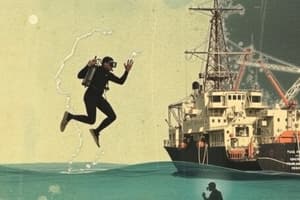Podcast
Questions and Answers
During the subsea spool tie-in operations, what primary factor contributed to the crane hook striking the diver's helmet?
During the subsea spool tie-in operations, what primary factor contributed to the crane hook striking the diver's helmet?
- Unexpected shifts in seabed conditions altered equipment positioning.
- Inadequate length of the crane pennant combined with poor visibility. (correct)
- A sudden, unforecasted increase in current that displaced the crane.
- The diver's failure to maintain a safe distance from the PHF.
What action taken during the incident demonstrated effective emergency response?
What action taken during the incident demonstrated effective emergency response?
- The crane operator immediately ceased all crane operations.
- Diver 2 promptly assisted Diver 1, ensuring no injuries were sustained and both returned to the dive bell safely. (correct)
- The diving supervisor immediately halted all operations to reassess safety protocols.
- The dive team performed an immediate on-site risk assessment.
What critical misjudgment led the crane operator to believe the crane hook had reached the seabed?
What critical misjudgment led the crane operator to believe the crane hook had reached the seabed?
- The crane hook came to rest on the top beam of the PHF, resulting in a 'no weight' reading on the crane wire. (correct)
- Communication errors led to the crane operator misinterpreting the diver's instructions.
- The crane operator disregarded the depth gauge readings.
- The crane operator relied solely on sonar readings without visual confirmation.
To improve safety in future subsea operations, which of the following strategies should be implemented?
To improve safety in future subsea operations, which of the following strategies should be implemented?
Before conducting the subsea operation, what additional measure could have prevented the incident?
Before conducting the subsea operation, what additional measure could have prevented the incident?
Flashcards
Subsea Crane Hook Incident
Subsea Crane Hook Incident
During subsea spool tie-in operations, a crane hook unexpectedly struck a diver's helmet due to the crane operator assuming the hook had reached the seabed.
Adequate Distance: Divers & Crane
Adequate Distance: Divers & Crane
Maintain sufficient distance between divers and the crane hook during subsea operations to reduce the risk of accidental contact, especially in limited visibility conditions.
Enhanced Visibility
Enhanced Visibility
In low visibility, use additional locating beacons, underwater cameras, or sonar to track critical equipment like the crane hook and prevent misjudgments about its location.
Clear Communication Protocol
Clear Communication Protocol
Signup and view all the flashcards
Updated Safety Procedures
Updated Safety Procedures
Signup and view all the flashcards
Study Notes
- During subsea spool tie-in operations, a crane hook unexpectedly struck a diver's helmet.
What Happened?
- Divers working on the seabed in poor visibility were performing subsea spool tie-in operations.
- After landing the pipe handling frame (PHF), the Diving Supervisor told the crane operator to lower the crane hook to allow the diver to disconnect rigging from the crane.
- The crane operator reported 'no weight' on the crane wire, so the Diving Supervisor assumed the hook had reached the seabed and instructed the diver to proceed.
- The crane hook unexpectedly struck the diver's helmet while the diver was positioned beneath the PHF.
- The diver was unharmed and returned to the dive bell and the dive was aborted.
- The diver's reclaim helmet was damaged beyond repair, including the side block, but the integrity of the helmet was maintained.
What Went Right?
- Diver 2 promptly assisted Diver 1, ensuring no injuries.
- Both divers returned to the bell safely immediately.
- Divers and the crane block had locating beacons for accurate tracking.
- Procedures, lifting plans, and Job Hazard Analysis (JHA's) were followed.
- The protective equipment absorbed the impact, so the diver was uninjured.
What Went Wrong?
- When the crane hook was lowered it came to rest on the top beam of the PHF.
- This resulted in a 'no weight' reading, leading the crane operator to believe the hook had reached the seabed.
- As the diver approached the disconnection point, the hook slipped off the beam and struck the side of the diver's helmet.
What Was The Cause?
- The crane pennant or stinger was an inadequate length and didn't provide enough distance between the divers and the crane hook.
- Poor visibility hindered observing the position of the crane hook.
Lessons and Actions
- Ensure adequate distance between divers and crane hook by using an adequate crane pennant/stinger length to maintain a safe distance.
- Use enhanced visibility aids and monitoring such as additional locating beacons, underwater cameras, or sonar, especially in environments with poor visibility.
- Reinforce communication and challenge assumptions regarding equipment position between the dive supervisor, crane operator, and divers.
- Project procedures were updated to specify minimum pennant lengths for different operations.
- Pre-operation inspections of all rigging and lifting equipment were conducted to ensure they meet safety standards.
- The Job Hazard Analysis (JHA) was updated to incorporate lessons learned, regarding safe distances, visibility, and communication requirements for subsea lifting operations.
Studying That Suits You
Use AI to generate personalized quizzes and flashcards to suit your learning preferences.




